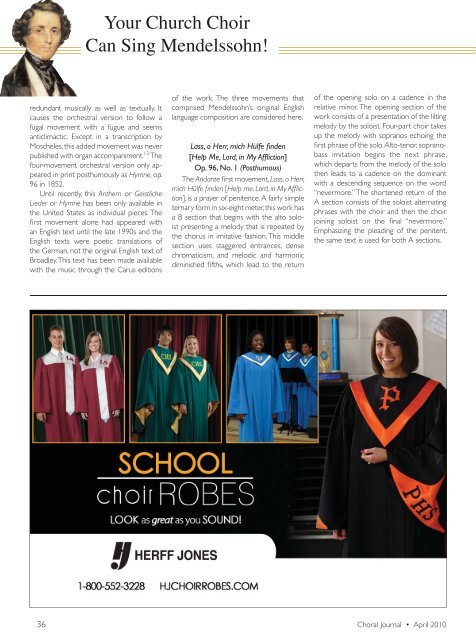Create successful ePaper yourself
Turn your PDF publications into a flip-book with our unique Google optimized e-Paper software.
Your Church Choir<br />
Can Sing Mendelssohn!<br />
redundant musically as well as textually. It<br />
causes the orchestral version to follow a<br />
fugal movement with a fugue and seems<br />
anticlimactic. Except in a transcription by<br />
Moscheles, this added movement was never<br />
published with organ accompaniment. 13 The<br />
four-movement orchestral version only appeared<br />
in print posthumously as Hymne, op.<br />
96 in 1852.<br />
Until recently, this Anthem or Geistliche<br />
Lieder or Hymne has been only available in<br />
the United States as individual pieces. The<br />
fi rst movement alone had appeared with<br />
an English text until the late 1990s and the<br />
English texts were poetic translations of<br />
the German, not the original English text of<br />
Broadley. This text has been made available<br />
with the music through the Carus editions<br />
of the work. The three movements that<br />
comprised Mendelssohn’s original English<br />
language composition are considered here.<br />
Lass, o Herr, mich Hülfe fi nden<br />
[Help Me, Lord, in My Affl iction]<br />
Op. 96, No. 1 (Posthumous)<br />
The Andante fi rst movement, Lass, o Herr,<br />
mich Hülfe fi nden [Help me, Lord, in My Affl iction],<br />
is a prayer of penitence. A fairly simple<br />
ternary form in six-eight meter, this work has<br />
a B section that begins with the alto soloist<br />
presenting a melody that is repeated by<br />
the chorus in imitative fashion. This middle<br />
section uses staggered entrances, dense<br />
chromaticism, and melodic and harmonic<br />
diminished fi fths, which lead to the return<br />
of the opening solo on a cadence in the<br />
relative minor. The opening section of the<br />
work consists of a presentation of the lilting<br />
melody by the soloist. Four-part choir takes<br />
up the melody with sopranos echoing the<br />
fi rst phrase of the solo. Alto-tenor, sopranobass<br />
imitation begins the next phrase,<br />
which departs from the melody of the solo<br />
then leads to a cadence on the dominant<br />
with a descending sequence on the word<br />
“nevermore.” The shortened return of the<br />
A section consists of the soloist alternating<br />
phrases with the choir and then the choir<br />
joining soloist on the fi nal “nevermore.”<br />
Emphasizing the pleading of the penitent,<br />
the same text is used for both A sections.<br />
36 Choral Journal • April 2010








